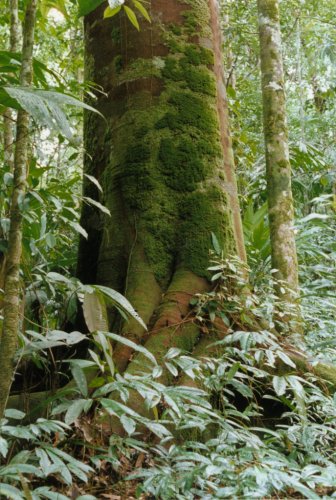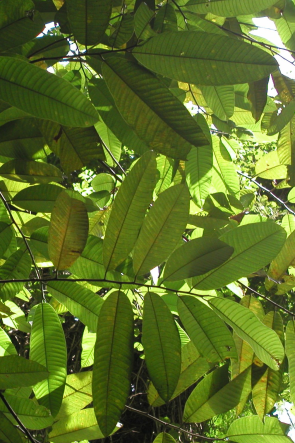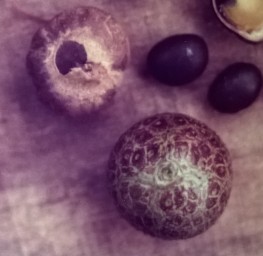Brosimum utile (HBK.) Pittier
Moraceae VACO LECHOSO, MASTATE, BREADNUT
Occasional evergreen tree of emergent proportions (30-40 m). Vaco is a vitally important species from a number of standpoints: ecologically it is a prolific producer food of forage for many rainforest fauna; traditionally, culturally, and historically it has been of tremendous and multiple utility to indigenous humans for centuries; and, perhaps most significantly, it is one of the  most impressive tree specimens to be seen anywhere in the world today, literally dwarfing most of its arboreal contemporaries.
most impressive tree specimens to be seen anywhere in the world today, literally dwarfing most of its arboreal contemporaries.
Description: Vaco has a very straight, perfectly cylindrical trunk that tapers only slowly as it reaches its lofty crown. Boles are typically fat, sporting a meter or more of breast-height girth, and they are surrounded by low, stubby, and broadly rounded buttress roots. The trunk remains branchless and columnar along most of its length, finally producing stout limbs some 40 m above the forest floor. Extending away from the bole for many meters, these limbs subdivide into the relatively thick and stubby twigs that form the outer edge of Vaco’s voluminous and rounded crown. Were it not for the exceptionally large leaves found on the tips of these twigs, the single-layered, bubble-like crown would appear quite thin. Vaco is protected by a thick covering of smooth, brown-gray bark that conceals copious quantities of white sap. If broken, the bark exudes this thick, viscous latex in harvestable amounts. Blue-gray lichens, flat and flaky, frequently take up residence on Vaco boles and contribute a characteristic, mottled aspect to their overall appearance. Leaves are simple, alternate and enormous, typically measuring 50 cm in length by 14 cm in width. Elliptical in shape, they and bear a prominent, pinnate vein pattern and a short – but sharp – (1 cm) drip tip. Blade surfaces are glossy green and smooth, with a soft, membranous texture. Long, 6 cm stipules protect newly emerging leaves but are shed soon after the blades mature. Sometime between September and November,  Vaco crowns begin to yellow as their leaves enter a period of slow senescence and are gradually shed. Late in the year (November or December) trees are briefly bare while flowering occurs and new foliage is generated. Vaco trees again possess a fresh, full leaf cover by late December or January. In the months following this deciduous period, the forest floor remains thickly carpeted by a crackling layer of curled, dead, and dry Vaco foliage. The unisexual flowers appear along the outermost twigs and branches during the short time that the trees are without leaves. Anatomically, male blossoms are small (1 cm), nearly sessile green spheres covered by short, brown stamens. Of similar shape, the presence of a single, bifid pistil distinguishes the flower’s female version. Great quantities of insects (especially bees) visit the flowers at this time and can be observed from the ground thronging to the petal-less, sepal-less, and essentially colorless blossoms. Flowering is a regular and annual event, with individual trees showing great precision in the timing of their own particular cycles. Synchronization between trees is rather less impressive, with late individuals fertile as long as two months after their earliest contemporaries. Blossoms are visible from late October to early December, though any one tree participates during only two or three weeks of this extended time span. After successful fertilization, the flowers lose their covering of stamens and the underlying orbs grow into Vaco fruits. Maturing as roughly spherical berries (3-4 cm), they sport a mottled surface pattern consisting of maroon splotches on a green background. In each, a thin, mealy layer of soft flesh (possessing a pleasantly sweet, wild taste) surrounds a single, large, brown seed (2.5-3 cm).
Vaco crowns begin to yellow as their leaves enter a period of slow senescence and are gradually shed. Late in the year (November or December) trees are briefly bare while flowering occurs and new foliage is generated. Vaco trees again possess a fresh, full leaf cover by late December or January. In the months following this deciduous period, the forest floor remains thickly carpeted by a crackling layer of curled, dead, and dry Vaco foliage. The unisexual flowers appear along the outermost twigs and branches during the short time that the trees are without leaves. Anatomically, male blossoms are small (1 cm), nearly sessile green spheres covered by short, brown stamens. Of similar shape, the presence of a single, bifid pistil distinguishes the flower’s female version. Great quantities of insects (especially bees) visit the flowers at this time and can be observed from the ground thronging to the petal-less, sepal-less, and essentially colorless blossoms. Flowering is a regular and annual event, with individual trees showing great precision in the timing of their own particular cycles. Synchronization between trees is rather less impressive, with late individuals fertile as long as two months after their earliest contemporaries. Blossoms are visible from late October to early December, though any one tree participates during only two or three weeks of this extended time span. After successful fertilization, the flowers lose their covering of stamens and the underlying orbs grow into Vaco fruits. Maturing as roughly spherical berries (3-4 cm), they sport a mottled surface pattern consisting of maroon splotches on a green background. In each, a thin, mealy layer of soft flesh (possessing a pleasantly sweet, wild taste) surrounds a single, large, brown seed (2.5-3 cm).  Nearly bare, this rounded seed is protected only by a thin, papery covering. Harvests begin as early as December for some trees, but are most universal during the months of January, February, and early March. Individual trees participate for only a fraction of this total period. Fruit crops are annually generated but their size may vary from season to season. Seed viability (for those that survive predation) is high and germination coincides with the onset of the rainy season (in April or May). Tall (30 cm) and gaunt, the easily recognizable seedlings sport two to three leaves suspended – flag-like – from the thin stems. Initially a deep maroon color, these first leaves eventually turn pink and then green during expansion.
Nearly bare, this rounded seed is protected only by a thin, papery covering. Harvests begin as early as December for some trees, but are most universal during the months of January, February, and early March. Individual trees participate for only a fraction of this total period. Fruit crops are annually generated but their size may vary from season to season. Seed viability (for those that survive predation) is high and germination coincides with the onset of the rainy season (in April or May). Tall (30 cm) and gaunt, the easily recognizable seedlings sport two to three leaves suspended – flag-like – from the thin stems. Initially a deep maroon color, these first leaves eventually turn pink and then green during expansion.
Similar Species: Vaco should be an easy tree to identify, thanks to its emergent proportions and unique, large foliage.
Natural History: Brosimum flowers are pollinated by bees and other insects, organisms that can be seen teeming around the highly visible blossoms (on bare Vaco branches) in November. Brown-hooded Parrots often feed upon – and destroy – large numbers of immature Vaco fruits (a phenomenon that has been observed in Cynometra hemitomophylla and Sterculia apetala as well). Scarlet Macaws eat the outer flesh of the mature fruit, as do White-faced Monkeys and other arboreal mammals.
Few seeds are ever found on the forest floor under Vaco trees. Heavy foraging by terrestrial mammals, like Agoutis and Pacas, may partially explain this observation, however many seeds undoubtedly remain concealed within the thick layer of dead Vaco leaves that blanket the forest floor at this time. The subsequent emergence of many young seedlings attests to the fact that not all seeds are browsed. (In fact, so many seedlings are successful that this tree often tends to form relatively dense stands.) Besides hiding seeds, the abundant leaf litter generated by Vaco trees may provide another benefit. Appearing, as it does, at the start of the dry season, this persistent layer of debris helps reduce the quantity of water lost to evaporation at a time when soil moisture levels are critical. Later, when the rains resume, these same dead leaves act as shock absorbers, reducing the force with which rain drops impact the soil and reducing the threat of soil erosion.
Uses: Traditionally, the thick, white sap produced by the Vaco (Cow) tree has been used by indigenous cultures as a milk substitute (hence the tree’s common name). Slits are made in the bark and the latex oozing from these wounds is collected. Many standing trees still bear the scars of machete slashes caused by contemporary latex collectors. Allen (1956) indicates that the sap, when fresh, can be used as cream in coffee or even whipped, sweetened and served for dessert. Apparently, the thick bark, when removed in large sections and beaten, becomes flexible and can be formed into a kind of fabric for blankets and clothes. Called mastate, the Boruca Indians of southwestern Costa Rica are known to have employed the bark in this way (Allen).
Both nuts (called Breadnuts in English) and fruits are edible, the former having a bread-like consistency – if not flavor.
Finally, Allen says that Vaco wood is white, soft, and not durable – though it is used for boxes in Ecuador.
Distribution: In MANP, the Vaco tree has a limited distribution – being mostly confined to a large population of trees concentrated on the hills behind the Manuel Antonio (third) beach. Such a condensed and confined arrangement lends itself to the notion that perhaps they were planted there by early, indigenous people of the region – a speculation that seems even more likely considering the great traditional value of this species to native cultures. Common on the Isla del Caño, Vaco trees there appear to form rows and to occupy regularly spaced positions – more impressive evidence that deliberate planting of this species once took place. Vaco is also found in the Northern sector of the Osa Peninsula – a region containing some of the largest specimens of this tree to be seen anywhere. It ranges from Costa Rica to Colombia, Venezuela, and Brazil.
Photos: Tree Trunk Trunk2 Bark Leaf Leaf2 Flower Flower2 Fruit Fruit2
